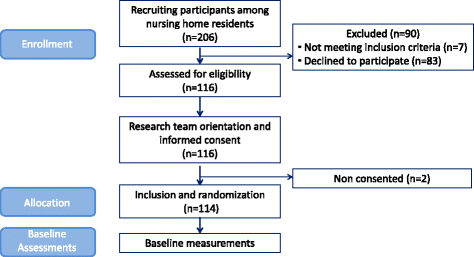Physical activity and fitness are associated with verbal memory, quality of life and depression among nursing home residents: preliminary data of a randomized controlled trial
- PMID: 29580209
- PMCID: PMC5869769
- DOI: 10.1186/s12877-018-0770-y
Physical activity and fitness are associated with verbal memory, quality of life and depression among nursing home residents: preliminary data of a randomized controlled trial
Abstract
Background: Few studies have simultaneously examined changes in physical, cognitive and emotional performance throughout the aging process.
Methods: Baseline data from an ongoing experimental randomized study were analyzed. Physical activity, handgrip, the Senior Fitness Test, Trail Making Test A, Rey Auditory-Verbal Learning Test, Quality of Life-Alzheimer's Disease Scale (QoL-AD) and the Goldberg Depression Scale were used to assess study participants. Logistic regression models were applied.
Trial registration: ACTRN12616001044415 (04/08/2016).
Results: The study enrolled 114 participants with a mean age of 84.9 (standard deviation 6.9) years from ten different nursing homes. After adjusting for age, gender and education level, upper limb muscle strength was found to be associated with Rey Auditory-Verbal Learning Test [EXP(B): 1.16, 95% confidence interval (CI): 1.04-1.30] and QoL-AD [EXP(B): 1.18, 95% CI: 1.06-1.31]. Similarly, the number of steps taken per day was negatively associated with the risk of depression according to the Goldberg Depression Scale [EXP(B): 1.14, 95% CI: 1.000-1.003]. Additional analyses suggest that the factors associated with these variables are different according to the need for using an assistive device for walking. In those participants who used it, upper limb muscle strength remained associated with Rey Auditory-Verbal Learning Test [EXP(B): 1.21, 95% CI: 1.01-1.44] and QoL-AD tests [EXP(B): 1.19, 95% CI: 1.02-1.40]. In those individuals who did not need an assistive device for walking, lower limb muscle strength was associated with Rey Auditory-Verbal Learning Test [EXP(B): 1.35, 95% CI: 1.07-1.69], time spent in light physical activity was associated with QoL-AD test [EXP(B): 1.13, 95% CI: 1.00-1.02], and the number of steps walked per day was negatively associated with the risk of depression according to the Goldberg Depression Scale [EXP(B): 1.27, 95% CI: 1.000-1.004].
Conclusions: Muscle strength and physical activity are factors positively associated with a better performance on the Rey Auditory-Verbal Learning Test, QoL-AD and Goldberg Depression Scale in older adults with mild to moderate cognitive impairment living in nursing homes. These associations appeared to differ according to the use of an assistive device for walking. Our findings support the need for the implementation of interventions directed to increase the strength and physical activity of individuals living in nursing homes to promote physical, cognitive and emotional benefits.
Trial registration: ACTRN12616001044415 (04/08/2016).
Keywords: Cognition; Depression; Exercise; Nursing home; Older adults; Physical activity; Quality of life.
Conflict of interest statement
Ethics approval and consent to participate
The present study has been approved by the Committee on Ethics in Research of the University of the Basque Country (Humans Committee Code M10/2016/105) and has also received a letter of support from the senior administrator of Matia, Caser Residential Care Facilities, Iurreamendi and Uzturre Nursing Homes. Furthermore, the study protocol has been registered under the Australian and New Zealand Clinical Trials Registry (ANZCTR) with the identifier: ACTRN12616001044415 and all participants have provided written informed consent based on documents approved by the University of the Basque Country Institutional Review Board. The study has been carried out in accordance with Good Clinical Practice, applicable local regulatory requirements, and the guiding principles of the Declaration of Helsinki. Universal Trial Number U1111–1185-6368.
Consent for publication
Not applicable.
Competing interests
The authors declare that they have no competing interest.
Publisher’s Note
Springer Nature remains neutral with regard to jurisdictional claims in published maps and institutional affiliations.
Similar articles
-
Determinants of quality of life in French nursing home residents across cognitive levels: a comparative study using convergent mixed-methods.BMC Geriatr. 2024 Jul 30;24(1):636. doi: 10.1186/s12877-024-05226-4. BMC Geriatr. 2024. PMID: 39080616 Free PMC article.
-
Comparing nutritional status, quality of life and physical fitness: aging in place versus nursing home residents.BMC Geriatr. 2025 Feb 15;25(1):102. doi: 10.1186/s12877-025-05751-w. BMC Geriatr. 2025. PMID: 39955492 Free PMC article.
-
Physical activity and physical fitness of nursing home residents with cognitive impairment: A pilot study.Exp Gerontol. 2017 Dec 15;100:63-69. doi: 10.1016/j.exger.2017.10.025. Epub 2017 Nov 5. Exp Gerontol. 2017. PMID: 29107061
-
Associations between physical function and depression in nursing home residents with mild and moderate dementia: a cross-sectional study.BMJ Open. 2017 Jul 20;7(7):e016875. doi: 10.1136/bmjopen-2017-016875. BMJ Open. 2017. PMID: 28729326 Free PMC article.
-
The use of physiotherapy in nursing homes internationally: A systematic review.PLoS One. 2019 Jul 11;14(7):e0219488. doi: 10.1371/journal.pone.0219488. eCollection 2019. PLoS One. 2019. PMID: 31295297 Free PMC article.
Cited by
-
The Effectiveness of Personalized Nursing on Quality of Life in Cardiovascular Disease Patients: A Systematic Review and Meta-analysis.Evid Based Complement Alternat Med. 2023 Jan 16;2023:4689732. doi: 10.1155/2023/4689732. eCollection 2023. Evid Based Complement Alternat Med. 2023. PMID: 36700041 Free PMC article. Review.
-
Prevalence of dynapenia and overlap with disability, depression, and executive dysfunction.Rev Saude Publica. 2023 Aug 4;57:43. doi: 10.11606/s1518-8787.2023057004580. eCollection 2023. Rev Saude Publica. 2023. PMID: 37556665 Free PMC article.
-
The effect of paracetamol on care dependency and daily functioning in persons with advanced dementia living in long-term care facilities.BMC Geriatr. 2024 Mar 22;24(1):279. doi: 10.1186/s12877-024-04795-8. BMC Geriatr. 2024. PMID: 38519888 Free PMC article. Clinical Trial.
-
Influence of Continuous Nursing Intervention on Treatment Compliance of Patients with Depression.Evid Based Complement Alternat Med. 2022 Sep 23;2022:7080678. doi: 10.1155/2022/7080678. eCollection 2022. Evid Based Complement Alternat Med. 2022. Retraction in: Evid Based Complement Alternat Med. 2023 Jun 21;2023:9762659. doi: 10.1155/2023/9762659. PMID: 36193155 Free PMC article. Retracted.
-
Longitudinal associations of housework with frailty and mortality in older adults: Singapore Longitudinal Ageing Study 2.BMC Geriatr. 2022 Dec 13;22(1):962. doi: 10.1186/s12877-022-03591-6. BMC Geriatr. 2022. PMID: 36514054 Free PMC article.
References
Publication types
MeSH terms
Associated data
Grants and funding
LinkOut - more resources
Full Text Sources
Other Literature Sources
Medical


